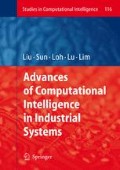In manufacturing, grinding is the process that shapes very hard work pieces with a high degree of dimensional accuracy and surface finish. The efficiency of the grinding process is regarded as a very important issue in the modern and competitive metal-mechanic industry, since it usually represents the major portion of processing costs [1–8]. The grinding process is strongly dependent on the topography surface of the grinding wheel, an expendable wheel thatcarries an abrasive compound on its periphery, since it is the cutting tool in grinding operations [1–3, 9–11]. The process responsible for preparing the topography surface of the grinding wheel is named dressing [2, 9, 12]. This process removes the current layer of abrasive, leading to a. fresh and sharp surface. Thus, the dressing process has an important effect on the efficiency of the grinding process, because the quality of the cutting tool directly affects the quality of the final product [2].
Access this chapter
Tax calculation will be finalised at checkout
Purchases are for personal use only
Preview
Unable to display preview. Download preview PDF.
References
Tönshoff, H.K., Jung, M., Männel, S., Rietz, W. (2000), Using acoustic signals for monitoring production processes. Ultrasonics 37, 681–686.
Maksoud, T.M.A., Atia, M.R. (2004), Review of intelligent grinding and dressing operations. Machining Science and Technology 8(2), 263–276.
Kwak, J.-S., Ha, M.-K. (2004b), Intelligent diagnostic technique of machining state for grinding. International Journal of Advacned Manufacturing Technology 23, 436–443.
Kwak, J.-S., Song, J.-B. (2001), Trouble diagnosis of the grinding process by using acoustic emission signals. International Journal of Machine Tools & Manufacture 41, 899–913.
Oliveira, J.F.G., Dornfeld, D.A. (2001), Application of AE contact sensing in reliable grinding monitoring. Annals of CIRP 2001, Berne, Switzerland 51(1), 217–220.
Toenshoff, H.K., Friemuth, T., Becker, J.C. (2002), Process monitoring in grinding. Annals of CIRP 51/2, 551–571.
Inasaki, I. (1999), Sensor fusion for monitoring and controlling grinding processes. International Journal of Advanced Manufacturing Technology 15, 730–736.
Oliveira, J.F.G., Dornfeld, D.A., Winter, B. (1994), Dimensional characterization of grinding wheel surface through acoustic emission. Annals of CIRP 1994, Berne, Switzerland 44(1), 291–294.
Li, X. (2002), A brief review: acoustic emission method for tool wear monitoring during turning. International Journal of Machine Tools & Manufacture 42, 157–165.
Kwak, J.-S., Ha, M.-K. (2004a), Neural network approach for diagnosis of grinding operation by acoustic emission and power signals. Journal of Materials Processing Technology 147, 65–71.
Oliveira, J.F.G., Silva, Eraldo Jannone Da, Biffi, Marcelo et al. (2002), New architecture control system for an intelligent high speed grinder. Abrasives Magazine, USA, no. 06, pp. 4–11.
Byrne, G., Dornfeld, D., Inasaki, I., Ketteler, G., König, W., Teti, R., (1995), Tool condition monitoring (TCM) – the status of research and industrial application. Annals of the CIRP 44/2: 541–567.
Tönshoff, H.K., Inasaki, I. (ed.) (2001), Sensors in Manufacturing. Wiley, New York.
Iwata, K., Moriwaki, T. (1977), Application of acoustic emission measurement to in-process sensing of tool wear. Ann. CIRP 26 (1–2), 19–23.
Winston, P.H. (1993), Artificial Intelligence. Addison-Wesley, Reading, MA.
Haykin, S. (1999), Neural Networks – A Comprehensive Foundation. Prentice-Hall, Englewood Cliffs, NJ.
Duda, R.O., Hart, P.E., Stork, D.G. (2000), Pattern Classification, 2nd Edn. Wiley, New York.
Hsu, C.-W., Chang, C.-C., Lin, C.-J. (2003), A practical guide to support vector classification. (http://www.csie.ntu.edu.tw/~cjlin/papers.html).
Smola, A.J., Barlett, P., Schölkopf, B. and Schurmmans, D. (1999), Advances in Large Margin Classifiers. MIT Press, Cambridge, MA.
Vapnik, V.N. (1995), The Nature of Statistical Learning Theory. Springer-Verlag, Berlin.
Lorena, A.C., Carvalho, A.C.P.L.F. (2003), Introdução às Máquinas de Vetores Suporte. Relatório Técnico do Instituto de Ciências Matemáticas e de Computação (USP/São Carlos), No. 192.
Quinlan, J.R. (1986), Induction of decision trees, Machine Learning 1, 81–106.
Mitchell, T.M. (1997), Machine Learning. McGraw-Hill, NY.
Kulkarni, A.D. (1994), Artificial Neural Networks for Image Understanding. Van Nostrand Reinhold – An International Thomson Publishing Company, New York.
Egmont-Petersen, M., Ridder, D., Handels, H. (2002), Image Processing with Neural Networks – A Review. Pattern Recognition 35, 2279–2301.
Haralick, R.M., Shanmugam, K., Dinstein, I. (1973), Textural features for image classification. IEEE Transactions on Systems, Man, and Cybernatics, SMC-3, 610–621.
Gotlieb, C.C., Kreyszig, H. (1990), Texture descriptors based on co-occurrence matrices. Computer Vision, Graphics, and Image Processing, 51, 70–86.
Powell, M.J.D. (1988), Radial basis function approximations to polynomials. Numerical Analysis 1987 Proceedings, 223–241, Dundee, UK.
Miccheli, C.A. (1986), Interpolation of scattered data: distances matrices and conditionally positive definite functions. Constructive Approximation 2, 11–22.
Gonzalez, R.C., Woods, R.E. (2002), Digital Image Processing. Prentice Hall, Englewood Cliffs, NJ.
Author information
Authors and Affiliations
Editor information
Editors and Affiliations
Rights and permissions
Copyright information
© 2008 Springer-Verlag Berlin Heidelberg
About this chapter
Cite this chapter
de Braga, A.P.S., de Carvalho, A.C.P.L.F., de Oliveira, J.F.G. (2008). Computational Intelligence Applied to the Automatic Monitoring of Dressing Operations in an Industrial CNC Machine. In: Liu, Y., Sun, A., Loh, H.T., Lu, W.F., Lim, EP. (eds) Advances of Computational Intelligence in Industrial Systems. Studies in Computational Intelligence, vol 116. Springer, Berlin, Heidelberg. https://doi.org/10.1007/978-3-540-78297-1_12
Download citation
DOI: https://doi.org/10.1007/978-3-540-78297-1_12
Publisher Name: Springer, Berlin, Heidelberg
Print ISBN: 978-3-540-78296-4
Online ISBN: 978-3-540-78297-1
eBook Packages: EngineeringEngineering (R0)

